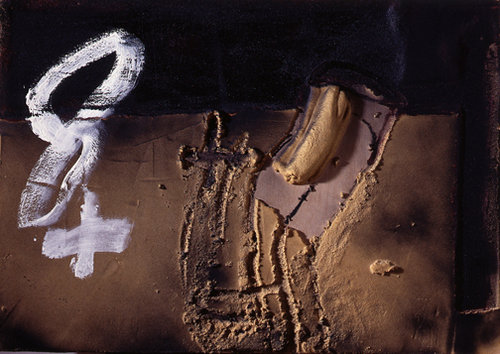Antoni Tapies
dal 26/2/2008 al 28/3/2008
Segnalato da
26/2/2008
Antoni Tapies
Waddington Custot Galleries, London
Recent Work

Waddington Galleries is delighted to announce an exhibition of recent paintings by Antoni Tàpies. The sixteen works range in scale from the smallest wooden panel Oval Vermell/Red Oval at 1 x 1½ft, to the monumental Pais d’Avatamsaka/Land of Avatamsaka at 8 x 17 ft.
The word tàpies translates from Catalan as walls and the notion of a wall has influenced how Tàpies has approached painting since the mid-fifties, when in Paris he discovered Brassai’s photographs of walls emblazoned with graffiti. For Tàpies the idea and image of the wall, whether as a symbol of spiritual solitude or political and religious suppression, holds a multitude of meanings. In his 1970 essay Communication on the wall*, Tàpies lists some of it’s associations as prison, the passing of time, signs of human imprints, the romantic prestige of ruins, inner contemplation… Walls also resonate with the medieval architecture of the towering buildings in the Gothic quarter of his home city, Barcelona - visually alluded to in the painting A+M, for example, illustrated above, with its dominating vertical format and solid crusted-material surface, inviting of mark-making.
These marks often appear an amalgam of Eastern calligraphy and Western graffiti. The painting T negra/Black T features the letter T which is frequently cited in Tàpies’ work and has numerous connotations – from the obvious reference to the leading letter of his surname and also his wife’s first name ‘Teresa’, it also acts as a pictographic symbol of the cross, one of the oldest ceremonial symbols found in almost every culture. When the lines of the T overlap it becomes a mathematical symbol or geographical position; a kiss; a candidate’s vote; a mark of faith and also an erasure.
Tàpies was born into a family of booksellers – he has a love of books and has a large library. A writer who has a major influence on his work is the Catalan philosopher and mystic Ramon Llull (1229-1316) author of the first ever novel in Catalan, Blanquerna who also constructed his own alphabet in which individual letters had their own meanings. In the painting Signes sobre matèria/Signs on matter the surface is covered with seemingly rapid notes of a formula or equation, an inscription of ancient text or fragmented hieroglyphics. The composition is balanced by a scrawling black incision of ambiguous graffiti leaving the viewer unsure if these are marks of anger from disaffected voices or the inscribed declaration of lovers.
Since the 1950s, when Tàpies started to introduce everyday substances and materials into his painting, he has used a constrained pallet of raw natural colour; burnt black, earth brown, wine red, rust red, the gold of sand or marble –colours and matter also suggestive of alchemy and the changing of elements. Transformation is emphasised physically in his paintings through the use of tangible materials (earth, sand, wood applied as media for making art) and spiritually through the use of universal signs and symbols. In Boca sobre tors/Mouth on torso the linear shape of a mouth is scratched into a body of paint that swells to the edges of the wooden board, revealing curves of hips and chest, as if personified through the seismic energy of a mudslide. It is body as matter and Tàpies’ perception of all things being interconnected, whether a metaphysical idea or feral cat, is explained simply by the title of one of the new paintings Sóc terra /I am earth.
Antoni Tàpies was born in 1923 and still uses the same house and studio in Barcelona, that was designed for him in 1963 by J.A.Coderch. In 1948 he helped co-found (with the Catalan poet Joan Brossa) the first post-war art movement in Spain known as Dua al Set and had his first solo exhibition at the Galeries Laietanes, Barcelona in 1950. His work is held in over eighty public collections worldwide including the Kunstmuseum, Basel, Centre Georges Pompidou, Paris, Solomon R Guggenheim Museum, New York and the Tate Gallery, London. In 1984 he established the Fundació Antoni Tàpies, which is also based in the modernist building Casa Montaner i Simó donated by the city of Barcelona in 1987. In 1993 UNESCO awarded him the Picasso medal and major retrospectives were staged at the Solomon R Guggenheim Museum (1995) and at the Museo Nacional Centro de Arte Reina Sofía (2000, 2004). In 2005 he was awarded the Lissone prize for his entire career.
* first published in 1970 as Communicacio sobre el mur in Antoni Tàpies, La practica de l’art (Barcelona : Edicions Ariel, Esplugues de Lllobregat), pp. 125-30
A fully illustrated colour catalogue accompanies the exhibition.
For further information or images please contact Leonie Holzwarth.
Waddington Galleries
11 Cork Street, London W1S 3LT
Opening times are from 10am to 6pm Monday to Friday and from 10am to 1:30pm on Saturdays (except late July and August)



